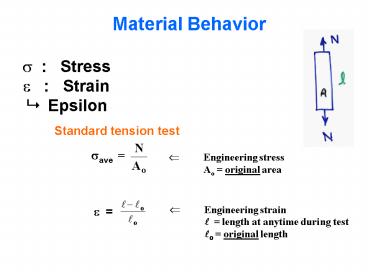Material Behavior PowerPoint PPT Presentation
Title: Material Behavior
1
Material Behavior
? Stress ? Strain ? Epsilon
Standard tension test ?ave
? Engineering stress Ao original area
? Engineering strain ? length at anytime
during test ?o original length
?
2
Remember that we plot stress-strain, not
load-elongation. Also note that strain is used
because of relativism.
3
(No Transcript)
4
?PL Proportional limit the end of linear
behavior
?yp yield point stress constant ? with
increasing ? ((ductile materials))
?ys yield strength stress at offset
(usually 0.2) ((for brittle materials with no
?yp))
?ult ultimate strength the maximum value
for ? in ??? curve
5
(No Transcript)
6
E 200 GPa ? ? Steel
30000 ksi ? 70 GPa ?
? Aluminum 10 ksi ?
20 GPa ? ? Concrete 3000
ksi ?
7
(No Transcript)
8
(No Transcript)
9
Ductile behavior The toughness of the material
is large, ((can have big strain before
rupture)) such as steel aluminum
f (temp., rate, type of loading, )
Brittle behavior opposite of ductile
behavior such as concrete glass
10
These two values ( reduction in area and
elongation) are also used for the description of
ductility as the toughness.
11
Isotropy Isotropic material if its elastic
properties are also the same in all directions
as steel and aluminum ((not wood)).
Homogeneity Homogeneous material if its
elastic properties are the same throughout
the body.
12
Poissons Ratio (?) ? nu
13
0 ? ? ? 0.5 ? range (theory)
0.2 ? ? ? 0.35 ? range for most engineering
materials
? ? w/o ? ? ? w/o ?
14
(No Transcript)
15
(No Transcript)
16
(No Transcript)
17
(No Transcript)
18
(No Transcript)
19
(No Transcript)
20
(No Transcript)
21
(No Transcript)
PowerShow.com is a leading presentation sharing website. It has millions of presentations already uploaded and available with 1,000s more being uploaded by its users every day. Whatever your area of interest, here you’ll be able to find and view presentations you’ll love and possibly download. And, best of all, it is completely free and easy to use.
You might even have a presentation you’d like to share with others. If so, just upload it to PowerShow.com. We’ll convert it to an HTML5 slideshow that includes all the media types you’ve already added: audio, video, music, pictures, animations and transition effects. Then you can share it with your target audience as well as PowerShow.com’s millions of monthly visitors. And, again, it’s all free.
About the Developers
PowerShow.com is brought to you by CrystalGraphics, the award-winning developer and market-leading publisher of rich-media enhancement products for presentations. Our product offerings include millions of PowerPoint templates, diagrams, animated 3D characters and more.

